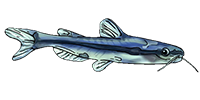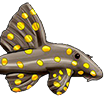/siluriformes/loricariidae/hypancistrus/sp%28l316%29/1.jpg)
/siluriformes/loricariidae/hypancistrus/sp%28l316%29/2.jpg) Female
Female/siluriformes/loricariidae/hypancistrus/sp%28l316%29/3.jpg) Dorsal view of male
Dorsal view of male/siluriformes/loricariidae/hypancistrus/sp%28l316%29/4.jpg) Dorsal view of female
Dorsal view of female/siluriformes/loricariidae/hypancistrus/sp%28l316%29/5.jpg) Male
Male/siluriformes/loricariidae/hypancistrus/sp%28l316%29/6.jpg)
/siluriformes/loricariidae/hypancistrus/sp%28l316%29/7.jpg) Close-up of male's cheek
Close-up of male's cheek/siluriformes/loricariidae/hypancistrus/sp%28l316%29/8.jpg) Close-up of female's cheek
Close-up of female's cheek/siluriformes/loricariidae/hypancistrus/sp%28l316%29/9.jpg) Female
Female/siluriformes/loricariidae/hypancistrus/sp%28l316%29/10.jpg) Genital papillae of female
Genital papillae of female/siluriformes/loricariidae/hypancistrus/sp%28l316%29/11.jpg) Pectoral fin spine of female
Pectoral fin spine of female/siluriformes/loricariidae/hypancistrus/sp%28l316%29/12.jpg) Male
Male/siluriformes/loricariidae/hypancistrus/sp%28l316%29/13.jpg) Close-up of mouth (male)
Close-up of mouth (male)/siluriformes/loricariidae/hypancistrus/sp%28l316%29/14.jpg) Spawning
Spawning/siluriformes/loricariidae/hypancistrus/sp%28l316%29/15.jpg) Eggs, just about to hatch!
Eggs, just about to hatch!/siluriformes/loricariidae/hypancistrus/sp%28l316%29/16.jpg) One day old fry
One day old fry/siluriformes/loricariidae/hypancistrus/sp%28l316%29/17.jpg) Five day old fry
Five day old fry/siluriformes/loricariidae/hypancistrus/sp%28l316%29/18.jpg) Nine day old fry
Nine day old fry/siluriformes/loricariidae/hypancistrus/sp%28l316%29/19.jpg) Eighteen day old fry
Eighteen day old fry/siluriformes/loricariidae/hypancistrus/sp%28l316%29/20.jpg) Five month old juveniles
Five month old juveniles/siluriformes/loricariidae/hypancistrus/sp%28l316%29/21.jpg) Five month old juveniles
Five month old juveniles/siluriformes/loricariidae/hypancistrus/sp%28l316%29/22.jpg) Comparision of L174 & L316 fry at 20 days.
Comparision of L174 & L316 fry at 20 days./siluriformes/loricariidae/hypancistrus/sp%28l316%29/23.jpg) Male
Male/siluriformes/loricariidae/hypancistrus/sp%28l316%29/24.jpg) Spawning
Spawning/siluriformes/loricariidae/hypancistrus/sp%28l316%29/25.jpg) Egg clutch
Egg clutch/siluriformes/loricariidae/hypancistrus/sp%28l316%29/26.jpg)
/siluriformes/loricariidae/hypancistrus/sp%28l316%29/27.jpg)
/siluriformes/loricariidae/hypancistrus/sp%28l316%29/28.jpg)
/siluriformes/loricariidae/hypancistrus/sp%28l316%29/29.jpg)
/siluriformes/loricariidae/hypancistrus/sp%28l316%29/30.jpg)
/siluriformes/loricariidae/hypancistrus/sp%28l316%29/31.jpg)
| Scientific Name | Hypancistrus sp. (L316) |
| Common Names | L316, Jari Zebra Pleco Jari-zebrasugemalle (Denmark) |
| Pronunciation | hype an siss truss |
| Etymology | A contraction of the Greek hypo (meaning less than) and ancistrus, an allusion to the reduced number of teeth (particularly in the lower jaw) found in this genus. |
| Size | 80mm or 3.1" SL. Find near, nearer or same sized spp. |
| Identification | Confused with other similarly patterned species. Distinguishable from other similarly sized and coloured l-numbers by the smaller than normal eye and reduced set of teeth. Patterning on this fish is a poor identification characteristic as these fish are among the most variably patterned of all l-numbers. Young fish are very attractive rivalling the zebra pleco (H. zebra) for looks. If you're new to l-numbers then it can look quite similar to a lot of them, but to the hard-core pleco watcher only really confused with L129 (Colombia) and L199 (Venezuela) the size of eye quickly distinguishes L316. L318 is also from the Rio Jari (the two have been jokingly titled ''BMW plecos'') may prove to be the same species as the only discernible difference is its lighter grey base colour. Oddly, it shares the exact same body sizes (including eyes) as L174, but is only similar visually at a young (<4cm) age. |
| Sexing | Sexually mature at around 6cm, so you should be able to select pairs or a breeding group when purchasing. As males mature they become darker, less contrastingly patterned and grow odontodes (small hard spines) all over the body that never entirely go away but are much more prominent in breeding males. |
| Distribution | Rio Jari in North Eastern Brazil. Amazon, Jari (click on these areas to find other species found there) Login to view the map. |
| Other Parameters | Like many exotic plecos, will not suffer poor aquarium maintenance regimes, lacklustre filtration or aimless feeding. |
| Feeding | Not picky, take a wide variety of live and frozen food such as bloodworms, brine shrimps, gammarus. Tablets, especially those with high percentage of Spirulina. User data. |
| Furniture | Rock caves or pipes should be provided one per male at least and driftwood is also appreciated but not mandatory. Plants are not molested but don't expect this guy to fix your algae problem. |
| Compatibility | A good community pleco, once settled (3-4 weeks) it will be seen during the day a bit more than many exotic plecos. Certainly not a territorial hell raiser, a pair or trio should be kept as reproduction isn't beyond the realms of possibility in a community tank. |
| Suggested Tankmates | Peaceful but choose tankmates wisely as these fish do not compete well for food with particularly fast or aggressive tankmates. |
| Breeding | Reasonably easy to breed applying the usual small pleco cave spawning method, produces clutches of 10-25 eggs, the young require around 7-9 months to reach a saleable size. |
| Breeding Reports | There is no breeding report. |
| Registered Keepers | There are 34 registered keepers, view all "my cats" data. |
| Wishlists | Love this species? Click the heart to add it to your wish list. There are 2 wishes to keep this species, see who wants what. |
| Spotters | Spotted this species somewhere? Click the binoculars! There are 8 records of this fish being seen, view them all. |
| Forum BBCode | |
| Search for H. sp. (L316) | |
| Look up H. sp. (L316) on AquaticRepublic.com | |
| LFS label creator ARN ref:1.4.7.1055 | |
| Last Update | 2022 Jan 21 11:43 (species record created: 2003 Jun 28 00:00) |




